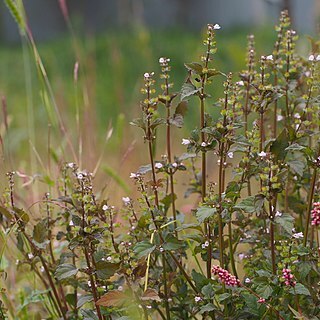Aromatic, annual herbs. Leaves usually glandular beneath. Verticillasters 2-flowered, secund, in terminal or axillary raceme-like inflorescence. Bracts minute or the lower ones large and leafy. Calyx campanulate, 10-nerved, often gibbous at base, subequally 5-toothed and 2-lipped; upper lip (in Mal. spp.) 3-toothed, lower lip 2-toothed, generally slightly longer; throat pubescent. Corolla exserted; lips short, upper lip notched, lower one 3-fid. Stamens 4, only upper pair perfect or 2; anthers 2-celled, cells divaricate; lower pair abortive, present or absent. Disk glandular, produced in the front. Style deeply bifid. Nutlets (in Mal. spp.) reticulate.
Cal usually 10-nerved, 2-lipped, the lips longer than the broad tube, the lower cleft to its base into narrowly triangular lobes, the upper cleft half length into broadly triangular lobes, the middle lobe the shortest; fruiting cal enlarged, hairy within; cor-tube about equaling the cal, the lips short, shallowly lobed; fertile stamens 2, straight; nutlets globose, areolate; annuals with small fls borne 2 at each node in the axils of small bracts, forming a slender, interrupted terminal spike. (Orthodon) 15, e. Asia.

